The Table Linen Market is estimated to be valued at USD 13.5 Billion in 2025 and is projected to reach USD 22.8 Billion by 2035, registering a compound annual growth rate (CAGR) of 5.4% over the forecast period.
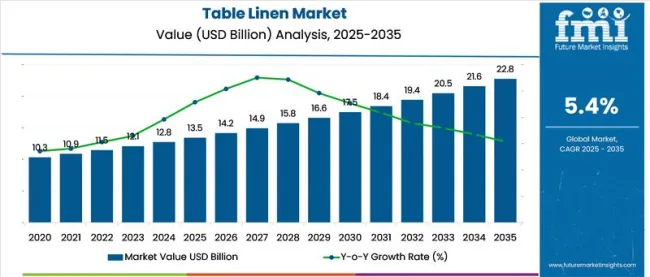
The table linen market is witnessing consistent growth, driven by rising consumer interest in home décor, increased frequency of home dining, and greater demand for quality table aesthetics. With consumers seeking to personalize living spaces, especially dining areas, demand has surged for durable, washable, and visually appealing table coverings.
Manufacturers are innovating with eco-friendly textiles, stain-resistant coatings, and seasonal design collections to meet changing lifestyle needs. Growth has also been reinforced by the hospitality sector’s post-pandemic rebound, as hotels and restaurants are renewing linen inventories with hygiene-focused and brand-aligned products.
Moreover, the growing popularity of hosting and home entertaining is influencing premium purchases in residential segments. E-commerce platforms, D2C brands, and physical retail chains are contributing to wider product accessibility. As sustainability and textile traceability gain traction, future demand is expected to favor responsibly sourced fabrics and multifunctional table linens designed for long-term use.
The market is segmented by Material Type, Application Type, and Sales Channel and region. By Material Type, the market is divided into Cotton, Linen Silk, Man-made Fibers, Crocheted or Knitted, and Others. In terms of Application Type, the market is classified into Residential and Commercial.
Based on Sales Channel, the market is segmented into Hypermarkets/Supermarkets, Independent Stores, Specialty Stores, Online Retailers, Direct Sales, and Other Sales Channel. Regionally, the market is classified into North America, Latin America, Western Europe, Eastern Europe, Balkan & Baltic Countries, Russia & Belarus, Central Asia, East Asia, South Asia & Pacific, and the Middle East & Africa.
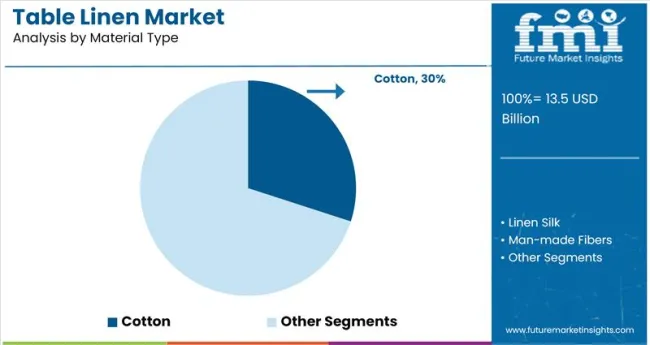
Cotton is projected to account for 30.0% of the total market share in 2025 within the material type category, making it the leading material in table linen production. This dominance is attributed to cotton’s natural fiber composition, breathability, and soft texture, which collectively enhance user comfort and presentation quality
Its strong absorbency and washability contribute to long-term utility, especially in homes and hospitality settings where reuse and ease of maintenance are key considerations. The material’s compatibility with embroidery, digital printing, and dyeing processes also allows manufacturers to deliver diverse aesthetic options.
Additionally, with growing interest in sustainable and biodegradable textiles, organic and responsibly farmed cotton variants are gaining momentum, further consolidating cotton’s leadership position in the segment.
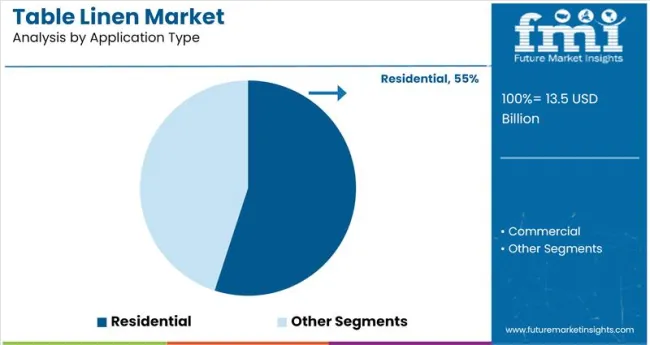
The residential application segment is expected to hold 55.0% of the overall table linen market share in 2025, securing its status as the dominant application area. This leadership is being driven by the increasing prioritization of home ambiance, dining aesthetics, and multiuse textile furnishings among consumers.
The expansion of urban housing, along with higher disposable incomes and increased e-commerce availability, has resulted in elevated consumption of decorative and functional table coverings. Residential consumers are also showing preference for linen sets that align with seasonal trends, minimalistic interiors, and coordinated kitchenware, reinforcing repeated purchases.
With the rise in home-based gatherings and casual dining, especially post-pandemic, table linens are now viewed as everyday essentials rather than occasional-use accessories. These evolving consumption patterns are expected to maintain the segment’s leading share over the forecast period.
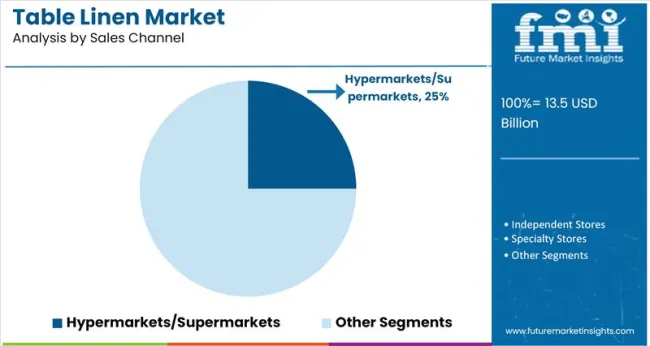
Hypermarkets and supermarkets are anticipated to command 25.0% of total sales channel revenue in 2025, positioning this channel as a major contributor to table linen market distribution.
The visibility and tactile buying experience offered by physical stores continue to influence consumer purchase decisions, particularly for home textile items where colour texture, and finish are key. Retail chains have increasingly expanded their in-store home décor sections, providing seasonal collections, bundled deals, and branded SKUs that attract impulse and bulk buyers.
Additionally, shelf-ready packaging, private labels, and promotional discounts in large-format stores have made table linens more accessible to a broad consumer base. While digital retail is expanding, hypermarkets remain critical for middle-income and value-conscious shoppers, maintaining their significance in overall market dynamics.
The mounting number of working-class professionals in developing countries, including India, Brazil and China is enabling consumers to increase their spending on decorative home products. Furthermore, the availability of natural and eco-friendly fibres is increasing the demand for decorative tableware products, which is expected to increase the demand for table linen.
Over the past few years, there has been a growing awareness among manufacturers and consumers about natural fibers to protect the environment from the manufacturing process and synthetic waste generated from scrap materials.
This factor is expected to generate significant revenue for the global market during the forecast period.
Leading players in the market are launching new products to effectively retain existing customers and effectively target potential customers. Innovations in product quality and the size of tablecloths and napkins play a major role in attracting the consumer.
Changing consumer preferences with the emergence of new styles and trends can lead to such product adoption. In this way, the market is expected to grow with new experiments and grow in the coming years.
For example, IKEA Holdings BV has launched a variety of mats and dining textile products made from 100% polyester yarn and seaweed as base material. The surface coating is clear nitrocellulose lacquer, which protects the tabletop surface and reduces noise from plates and flatware.
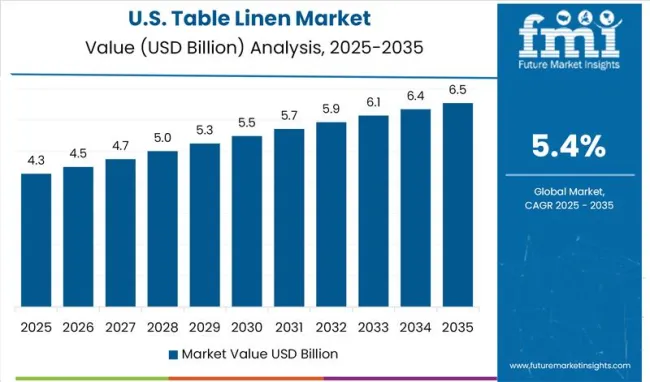
In the North American market, table linen is booming over the past few years and is expected to rise owing to spurring consumers’ income and their spending capacity. The growing demand for tablecloths to enhance the dining area with greater aesthetic appeal is fueling industry growth in the area.
In addition, the existence of developed economies such as the USA is benefiting market expansion due to the strong base of branded manufacturers and well-established industrial infrastructure.
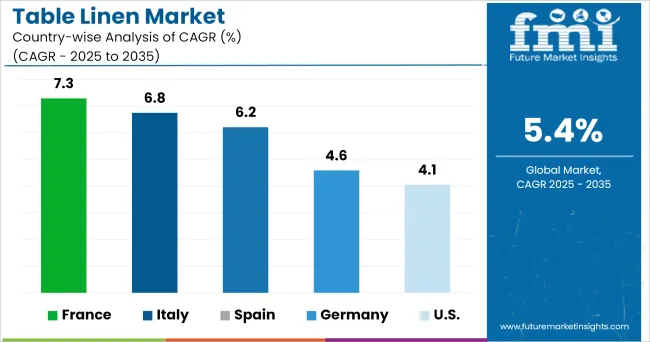
The demand for table linen in the European market is estimated to grow significantly in the upcoming years. In addition, the growing trend of using anti-stain tablecloths in order to cut off maintenance costs is fueling the market growth in this region.
Moreover, E-commerce portals are expected to grow as a major selling medium by providing value-added services including cash on delivery, free home delivery, overseas shipping facilities, return/exchange policy and coupon benefits are expected to remain a prominent market trend in the European region.
In order to reach a huge customer base, companies are offering their products through various online retailers such as Amazon, and Flipkart. The availability of a wide range of premium as well as products of international brands is one of the major factors in approving online purchases in this region.
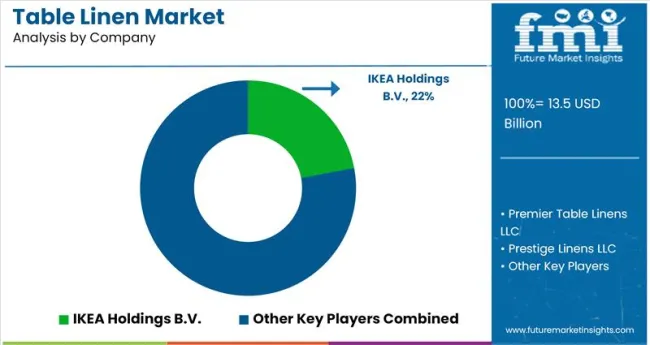
Some of the leading manufacturers of table linen market include
The report is a compilation of first-hand information, qualitative and quantitative assessments by industry analysts, and inputs from industry experts and industry participants across the value chain.
The report provides an in-depth analysis of parent market trends, macro-economic indicators and governing factors along with market attractiveness as per segments. The report also maps the qualitative impact of various market factors on market segments and geographies.
The global table linen market is estimated to be valued at USD 13.5 Billion in 2025.
The market size for the table linen market is projected to reach USD 22.8 Billion by 2035.
The table linen market is expected to grow at a 5.4% CAGR between 2025 and 2035.
The key product types in table linen market are cotton, linen silk, man-made fibers, crocheted or knitted and others.
In terms of application type, residential segment to command 55.0% share in the table linen market in 2025.






Full Research Suite comprises of:
Market outlook & trends analysis
Interviews & case studies
Strategic recommendations
Vendor profiles & capabilities analysis
5-year forecasts
8 regions and 60+ country-level data splits
Market segment data splits
12 months of continuous data updates
DELIVERED AS:
PDF EXCEL ONLINE
Table and Kitchen Linen Market Size and Share Forecast Outlook 2025 to 2035
Tableware Market Size and Share Forecast Outlook 2025 to 2035
Tablet Hardness Testers Market Size and Share Forecast Outlook 2025 to 2035
Table Tents Market Size and Share Forecast Outlook 2025 to 2035
Tabletop CNC Milling Machines Market Analysis - Size, Share, and Forecast Outlook 2025 to 2035
Tablet Packing Machine Market Size and Share Forecast Outlook 2025 to 2035
Tablets for Oral Suspension Market Analysis Size and Share Forecast Outlook 2025 to 2035
Tablet Press Machines Market Size and Share Forecast Outlook 2025 to 2035
Tablet Based E-Detailing Market Size and Share Forecast Outlook 2025 to 2035
Tablet And e-Reader Application Processor Market Size and Share Forecast Outlook 2025 to 2035
Tabletop Pizza Oven Market Size and Share Forecast Outlook 2025 to 2035
Tableau Services Market Size and Share Forecast Outlook 2025 to 2035
Tableland Tourism Market Size and Share Forecast Outlook 2025 to 2035
Tablet Market Analysis by Product Type, End-Use, Operating System, and Region Through 2035
Market Share Distribution Among Tablets And Capsules Packaging Companies
Key Players & Market Share in Tablet Packing Machine Industry
Competitive Landscape of Tableware Providers
Tablets and Capsules Packaging Market Growth, Trends, Forecast 2025-2035
Tablet Counting Machine Market Trends & Forecast 2024-2034
Tablet Cartons Market

Thank you!
You will receive an email from our Business Development Manager. Please be sure to check your SPAM/JUNK folder too.
Chat With
MaRIA